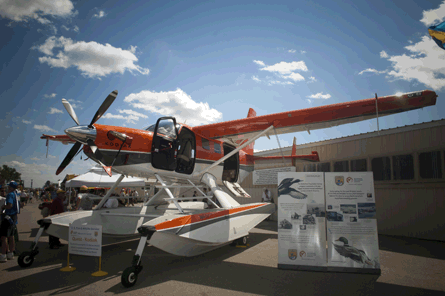The US Fish and Wildlife Service is taking delivery of nine Quest Kodiak floatplanes at AirVenture 2010.
The US Fish and Wildlife Service’s Migratory Bird Management programme says the aircraft will be used primarily to conduct migratory bird surveys and monitor and manage waterfowl populations. The service plans to use the Quest to replace some of the older aircraft in its fleet and expand its coverage area.
Four of the aircraft will be based in Alaska, where coverage is expanding to include the Arctic region. The service currently cannot use aircraft to conduct bird surveys in the Arctic because its current 15-aircraft fleet, which primarily includes Cessna 185s and 206s, lacks the range to cover the vast territory. Its fleet also uses avgas while the Kodiak takes jet fuel, which is typically more available in remote regions.
 |
|---|
©Billypix |
The Kodiak pictured here, on display in front of the federal pavilion at the show, will be based in Louisiana and flown by pilot Fred Roetker. This particular aircraft has already flown without floats for about 500 hours. The US Fish and Wildlife Service has been using the aircraft for 18 months on training missions to prepare pilots including Roetker for the delivery of the Kodiak floatplanes and some missions which could be completed using fixed gear.
“We’re really excited. We’ve been waiting for the floats for a long time,” says Roetker, who previously flew a Cessna 206 amphibian.
 |
|---|
© Billypix |
Quest, which currently only produces about 24 Kodiaks per year, first certified the Kodiak in 2007. But the Kodiak floatplane was certified by Wippaire, which supplied its Wipline 7000 amphibious floats and oversaw the modification effort. Wipline secured the supplemental type certificate for the modification in June, allowing the fixed-gear Kodiak that has been used by the Fish and Wildlife Service since early 2009 to be modified. The certification also allowed Wipaire to install floats on the other eight aircraft acquired by US Fish and Wildlife Service, which were already completed by Quest but not yet delivered. The service signed off on the papers for all the aircraft last week and they will be formally delivered at a ceremony on 30 July at Oshkosh.
Since achieving certification, Wipaire also has delivered one Kodiak floatplane to a commercial customer. This aircraft is on display at the AirVenture Seaplane Base.
While all the Migratory Bird Management aircraft will be based with individual pilots, they are moved throughout the US and Canada depending on the season. “We migrate as do the birds,” says John Solberg, a North Dakota-based pilot of a Migratory Bird Management Cessna 185. Adds Roetker: “The airplanes stay with the ducks.”
- All the latest news, video and images from EAA AirVenture Oshkosh 2010
Source: FlightGlobal.com



















